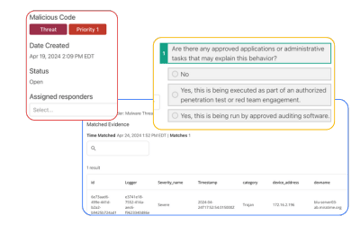This blog was initially published by Cybersecurity Insiders.
The recent cyberattacks affecting water treatment plants and systems across the nation shed light on the need for cybersecurity measures that safeguard these essential services. In fact, the Environmental Protection Agency found that about 70% of utilities inspected by federal officers over the last year violated standards meant to prevent cybersecurity breaches.
With government entities applying pressure to address cybersecurity vulnerabilities, decision makers might understandably feel overwhelmed about how to move forward. The road to implementing comprehensive cybersecurity measures can feel daunting, given the steep time and cost investments associated with transforming systems, as well as a lack of cybersecurity expertise. Limited budgets and resources, aging infrastructure and legacy systems and balancing operational efficiency with security requirements are just a few challenges weighing heavily on water treatment plant leaders.
So, what can water plant leaders do? This article will discuss four steps decision makers can take to implement effective cybersecurity measures that safeguard their systems and protect them from outside threats, enabling them to carry on business as usual.
Conduct Network Segmentation
Water treatment plants can begin with network segmentation, the practice of dividing a computer network into smaller, distinct subnetworks or segments. Network segmentation enhances security to ensure operational continuity and protect public health.
For example, let’s say a plant’s network can be divided into several segments, each serving different functions and containing specific types of devices and systems. The Operational Technology (OT) segment contains multiple components, including Supervisory Control and Data Acquisition (SCADA) systems, Programmable Logic Controllers (PLCs), Human-Machine Interfaces (HMIs), sensors, and actuators.
This segment manages the core operational processes of water treatment, such as monitoring and controlling water flow, filtration systems and chemical dosing. To protect this segment, decision makers should implement segmentation to isolate it from others, making it more difficult for cyber attacks to move laterally. If an attacker compromises one segment, the network confines the impact, preventing the attacker from infiltrating the entire system. This containment minimizes potential damage and disruption to water treatment processes, safeguarding the water supply.
Segmentation also facilitates better access control and monitoring. Water treatment plant leaders should assign specific credentials to each segment, ensuring that only authorized personnel can access sensitive areas. This granular control enhances the overall security posture and helps quickly identify and mitigate security breaches.
Furthermore, network segmentation simplifies compliance with regulatory requirements by isolating and protecting sensitive data, which is crucial for avoiding legal and financial repercussions.
Regularly Update Systems
Water treatment plant decision makers should run vulnerability scans on their networks and update systems with the latest security patches and software versions to mitigate vulnerabilities.
U.S. authorities examining the recent cyberattacks discovered that the compromised facilities were using antiquated equipment linked to the internet, secured with inadequate passwords. Implementing multi-factor authentication (MFA) and robust password policies can add an extra layer of security against unauthorized access. Decision makers should consider partnering with a cybersecurity consultant to support this process, as they will be able to compare current security measures against industry standards and best practices.
Implement Employee Training
Water treatment plant leaders should conduct employee cybersecurity training to reduce human error, which is a common vulnerability in security breaches. Training ensures that employees can recognize and respond to cyber threats, such as phishing attacks. It also promotes best practices, like using strong passwords and identifying suspicious activity, enhancing the overall security posture. Leaders should consider participating in CISA cybersecurity training and exercises to enhance security and resiliency.
The CISA also has information on recognizing and averting phishing attacks, which employees with a lack of cybersecurity awareness may fall victim to by clicking on fake emails or providing sensitive information such as passwords, usernames or even credit card numbers.
Informed employees can act as the first line of defense, quickly mitigating potential threats and maintaining the integrity of critical systems. Regular cybersecurity training is essential to create a security-aware culture and protect the plant’s operations and public health.
Invest in Advanced Threat Detection and Response Software
It’s essential that water treatment plant leaders can swiftly identify contaminants and ensure regulatory compliance to maintain public trust in the safety and reliability of the water supply. As a result, water plant decision makers should research and invest in advanced threat detection and response software. Prioritize a solution that doesn’t require extensive cybersecurity expertise to manage.
Managed security service providers can provide vulnerability scanning, antivirus and system upgrades to prevent intrusions and keep water plants running securely for potentially lower overhead costs than hiring and maintaining an in-house security team. Look for providers and solutions that deliver real-time detection and automated response to contain threats faster, reducing the risk of ransomware and other infections across networks.
Safeguarding Systems Now
There are many challenges water treatment plant leaders are facing in terms of cybersecurity, including limited budgets, fewer resources and outdated systems. However, there are small steps these leaders can incorporate to improve their cybersecurity posture now.
A good place to start is to implement network segmentation, regularly update systems and enforce multi-factor authentication to enhance security. Employee training is essential to reduce human error and promote a security-aware culture. Investing in advanced threat detection software ensures real-time protection against cyber threats. By taking these steps, decision makers can safeguard critical infrastructure, ensure the continuous delivery of safe water and protect public health.
More from the blog
View All Posts
Building A Cyber-Aware Company Culture: Make It A Team Effort
Read More
On-Demand: Navigating Cybersecurity: Trends, Insights, and Strategies for 2024
Read More
RSAC 2024: Automating the SOC; CISO Challenges and How to Solve the People Problem
Read MoreSubscribe to email updates
Stay up-to-date on what's happening at this blog and get additional content about the benefits of subscribing.

